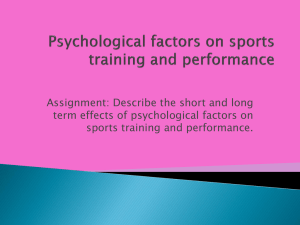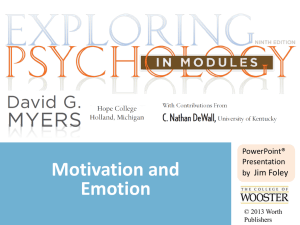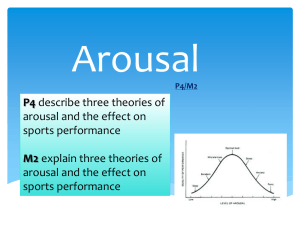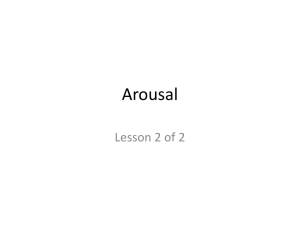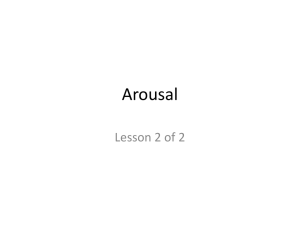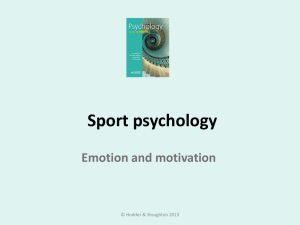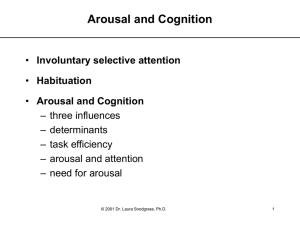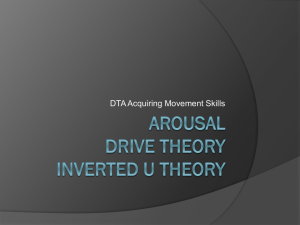Year 10 lesson inverted U theory
advertisement
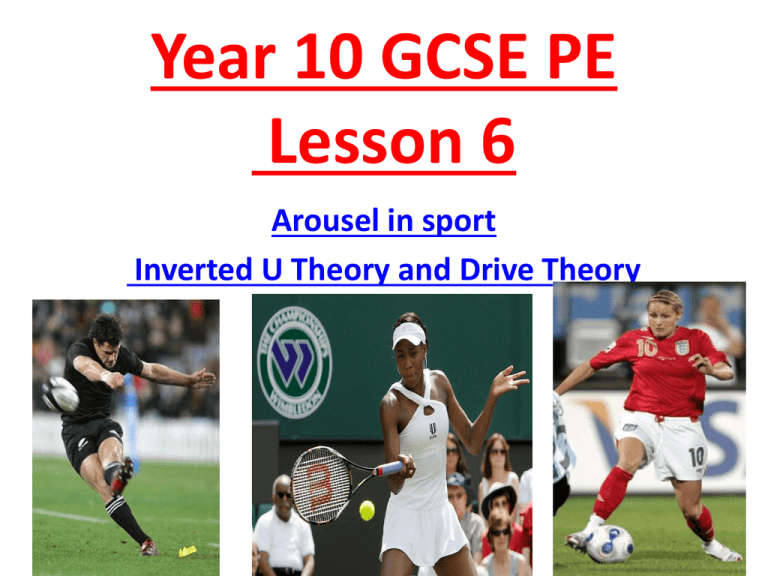
Year 10 GCSE PE Lesson 6 Arousel in sport Inverted U Theory and Drive Theory Aim & Objectives • To develop further your knowledge and understanding of the importance of motivation in sport. • Be able to explain what arousal in sport and the purpose of the Inverted U theory. Starter. 1.Define the term motivation 2. There are two types of motivation what are they? Answers to Starter . Question 1 Definition Level A ‘Motive – The desire to fulfil a need’ (Cox, 1988) ‘The internal mechanisms and external stimuli which arouse and direct behaviour’ (Sage, 1977) Definition Level B ‘Motivation is the driving force that compels people to do something’ Question 2: • Intrinsic and Extrinsic Motivation Arousal •Arousal is when a team is motivated to do something. •When your Arousal levels are high you are more likely to perform better •Like wise if your Arousal level is low you will lack energy , focus and will probably not perform as well. •However too much arousal will get you over excited and you will end up playing badly. •In cricket for example a player who is aroused will be great at fielding however over-arousal will lead to bad fielding and dropped catches. AROUSAL • Motivation is also an effective way of stimulating the level of arousal or state of readiness in a performer. A team captain may be a good example when he/she is ‘psyching their team up before a game’ 0VER - AROUSAL • Some performers can get aroused very easily this can case problems, and effect their performance Inverted U Theory •The inverted U theory is a graph that can be used to show the relation between the performance of a player and the arousal level that individual is at. •The graph line is curved to show that the higher the arousal level is the better the performance UNTIL THE OPTIMUM POINT •After the optimum point the higher arousal level get the worse your performance gets this is known as OVER-AROUSAL. SPORT PS CHOLOG The inverted U theory maps these different levels on a graph, as seen below: > At point one the players level of arousal is low, and so is their performance level. > At point two the players performance and motivation is at its peak. This is their optimum level. > At point three the arousal level is too high as the player becomes increasingly stressed and agitated. This causes their performance to drop considerably. 2 1 3 I N V E R T E D U motivation, Arousal and Performance • Motivation is related to the intensity and direction of behaviour. • That is, the level of arousal and the way in which we behave affect our motivation and hence performance. There are currently two theories which try to explain this link: SPORT PS CHOLOG > Arousal levels are different in different sports. > For example optimum arousal in snooker or darts may only be low arousal in rugby. > This is because snooker and darts require a low arousal in order to focus and concentrate whereas rugby requires a high optimum arousal due to the physicality of the sport. A R O U S A L Over arousal - Tyson V Holyfield, the infamous ear biting incident Hull's Drive Theory: • This demonstrates a linear relationship between performance and arousal. • This means at low levels of arousal, performance is low and performance increases in line with an increase in arousal. This is shown in the graph below. Motivation is thought to be a combination of the drive within us to achieve our aims and the outside factors which affect it. With this in mind, motivation has the following two forms, intrinsic motivation and extrinsic motivation. • This theory also explains that novices to the sport often do not perform well under pressure and their skill level decreases due to poor habits and ill- learned techniques. • Habits are described as the performance which is dominant within each person. Experienced athletes tend to perform better under pressure due to their superior skills and the use of stress management techniques. This theory can be expressed using the following equation: Performance = habit x drive (arousal) Homework On wikispaces complete th by Wednesday 24 October and hand in during your practical lesson.
